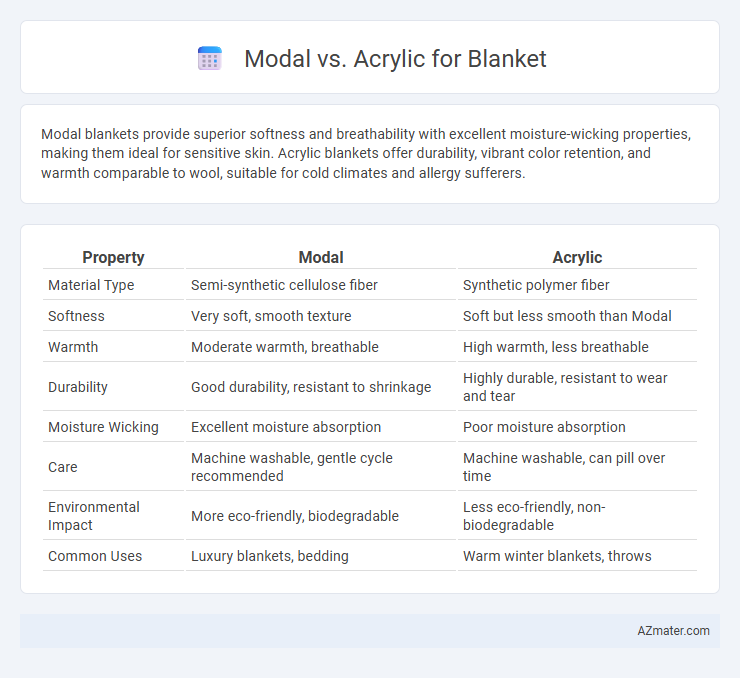Modal blankets provide superior softness and breathability with excellent moisture-wicking properties, making them ideal for sensitive skin. Acrylic blankets offer durability, vibrant color retention, and warmth comparable to wool, suitable for cold climates and allergy sufferers.
Table of Comparison
| Property | Modal | Acrylic |
|---|---|---|
| Material Type | Semi-synthetic cellulose fiber | Synthetic polymer fiber |
| Softness | Very soft, smooth texture | Soft but less smooth than Modal |
| Warmth | Moderate warmth, breathable | High warmth, less breathable |
| Durability | Good durability, resistant to shrinkage | Highly durable, resistant to wear and tear |
| Moisture Wicking | Excellent moisture absorption | Poor moisture absorption |
| Care | Machine washable, gentle cycle recommended | Machine washable, can pill over time |
| Environmental Impact | More eco-friendly, biodegradable | Less eco-friendly, non-biodegradable |
| Common Uses | Luxury blankets, bedding | Warm winter blankets, throws |
Introduction to Modal and Acrylic Fabrics
Modal fabric, derived from beech tree pulp, offers exceptional softness, breathability, and moisture-wicking properties, making it ideal for blankets that prioritize comfort and temperature regulation. Acrylic fabric, a synthetic fiber known for its durability, vibrant color retention, and resistance to moths and mildew, provides warmth similar to wool while being lightweight and easy to care for. Both fabrics serve distinct purposes in blanket manufacturing, with Modal emphasizing natural feel and breathability, and Acrylic highlighting resilience and vibrant aesthetics.
Key Characteristics of Modal
Modal fabric, derived from beech tree pulp, offers exceptional softness and breathability, making it ideal for blankets that require a smooth and gentle touch on the skin. Its high moisture-wicking capacity keeps users dry and comfortable, outperforming traditional cotton in retaining shape after multiple washes. Superior resistance to pilling and shrinkage ensures modal blankets maintain a luxurious feel and durable appearance over time.
Key Characteristics of Acrylic
Acrylic blankets are known for their lightweight, warm, and hypoallergenic properties, making them ideal for sensitive skin and cold climates. Unlike modal, acrylic fibers offer excellent durability, resistance to wrinkles, and vibrant color retention after multiple washes. Their moisture-wicking ability and quick-drying nature enhance comfort, distinguishing acrylic as a low-maintenance, practical option for everyday bedding.
Softness and Comfort Comparison
Modal fabric offers superior softness due to its finer fibers and higher moisture absorption, resulting in a smooth, silky feel ideal for blankets. Acrylic blankets, while soft, tend to be less breathable and can retain heat, potentially reducing overall comfort during extended use. Choosing modal enhances comfort with its lightweight, breathable texture, making it preferable for cozy, soft blankets.
Durability and Longevity
Modal fibers offer superior durability and resistance to pilling compared to acrylic, maintaining softness and strength even after multiple washes. Acrylic blankets often experience quicker wear and loss of fiber integrity, leading to reduced lifespan and increased vulnerability to stretching or shedding. Modal's resilience and ability to retain color intensity contribute to longer-lasting blankets that endure regular use without significant degradation.
Warmth and Insulation Properties
Modal blankets offer moderate warmth with excellent breathability and moisture-wicking properties, making them ideal for mild to cool weather. Acrylic blankets provide superior insulation and retain heat effectively, mimicking wool's warmth while being lightweight and hypoallergenic. For optimal warmth, acrylic blankets are preferred in colder climates, whereas modal blankets are better suited for comfortable layering and temperature regulation.
Breathability and Moisture Management
Modal fabric offers superior breathability and moisture-wicking properties compared to acrylic, making it ideal for blankets used in warmer climates or for individuals prone to overheating. Modal's natural fibers allow air to circulate more freely, enhancing comfort by keeping the skin dry and cool. Acrylic blankets, while warm and lightweight, tend to retain moisture and provide less effective ventilation, which can lead to a less comfortable sleeping environment.
Care and Maintenance Requirements
Modal blankets require gentle washing with cold water and mild detergent to maintain their softness and prevent shrinking, ideally air-dried or tumble dried on low heat. Acrylic blankets are more durable and machine-washable, tolerating warm water and low to medium heat drying without significant damage or color fading. Both materials benefit from avoiding bleach and fabric softeners to preserve fiber integrity and prolong the blanket's lifespan.
Environmental Impact and Sustainability
Modal fibers are derived from beech tree pulp using a more sustainable closed-loop process that recycles water and chemicals, resulting in a lower environmental footprint compared to traditional rayon. Acrylic blankets rely on petroleum-based synthetic fibers, contributing to higher carbon emissions and non-biodegradable waste, which negatively impact ecosystems. Choosing modal blankets supports eco-friendly practices through renewable raw materials and enhanced biodegradability, making them a more sustainable option for environmentally conscious consumers.
Which Blanket Material is Right for You?
Modal blankets offer exceptional softness, moisture-wicking properties, and durability, making them ideal for those seeking a breathable and eco-friendly option. Acrylic blankets provide warmth, affordability, and easy care, appealing to individuals looking for a cozy and low-maintenance alternative. Choosing between modal and acrylic depends on your preferences for sustainability, softness, and thermal insulation.

Infographic: Modal vs Acrylic for Blanket
 azmater.com
azmater.com